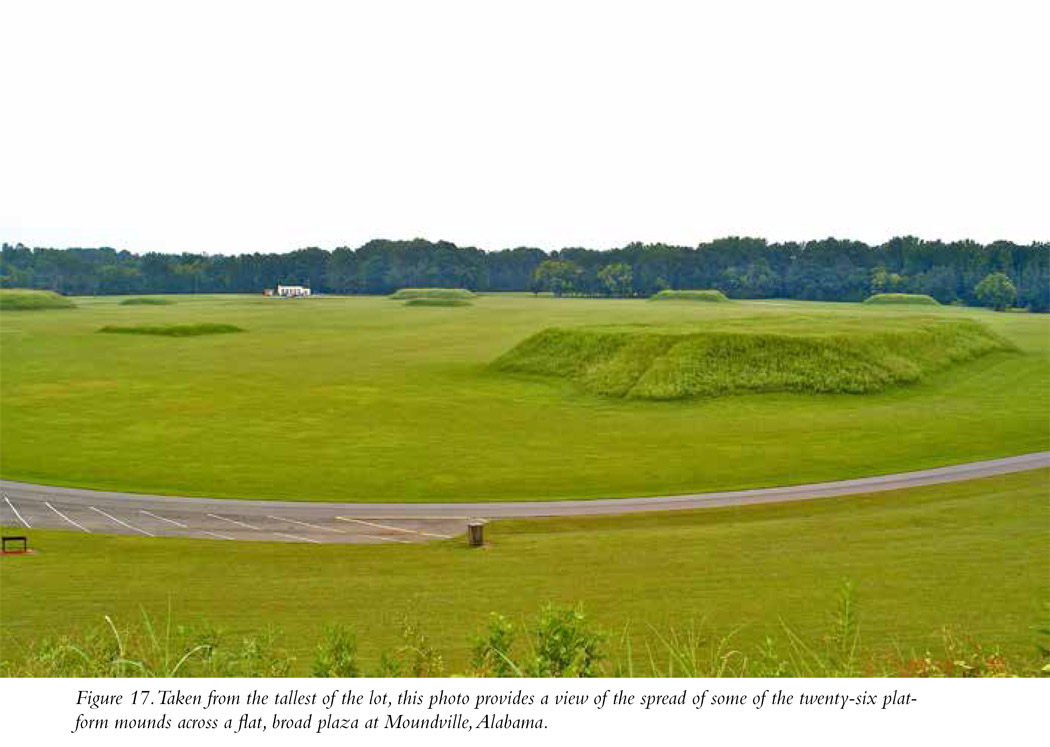
Moundville, Alabama
Journal Entry
August 15, 2008
It is incredibly impressive to stand in the expansive plaza at the Moundville archaeological site and look out on a dense concentration of twenty-six monumental, flat-topped pyramids of earth constructed in this one place by the people of the surrounding region. It is impossible not to try to imagine what it must have looked like in its heyday—a busy hub of activity as hundreds of laborers moved thousands of basket loads of dirt to create massive earth platforms for the homes of their chiefs and priests. It’s impressive but also perplexing. What possessed all those people—mostly farmers who were otherwise pretty busy producing food for their families and their communities—to congregate at the place we call Moundville and devote so much of their time and energy to create all these elevated platforms for the homes of an elite class of people? Was that labor a form of tax, payment for the privilege of being a protected member of a society in which Moundville served as the spiritual, political, social, and economic capital? That’s probably the case. But who were the elites, and how did they obtain the elevated status that earned them the elevated placement of their houses? That is unclear. Today, however, we can marvel at the beauty and symmetry of the mounds and appreciate the work that went into their construction. We also can marvel at the success of a society able to organize and command the labor of its citizens to create so many impressive monuments.
What You Will See
Moundville is a truly spectacular cluster of mounds, any one of which might be the large, primary mound at most other mound builder sites. Altogether, there are twenty-six large platforms of earth demarcating a plaza that covers about 20 acres (Figure 17). The site itself, as was the case for the other significant temple mound sites visited in my odyssey, was surrounded by a wall of wooden logs called a palisade. In this case, the palisade encloses the site on three sides of its rectangular footprint; the fourth side is demarcated by the Black Warrior River.
The largest truncated pyramid at the site, Mound B, stands about 58 feet high and is located at one end of the plaza. This appears to be the platform on which Moundville’s ruler’s house was built. A replica of that structure stands on top of the mound. It cannot be entered, and unfortunately both the modern wooden stairway and the reconstructed building were in pretty rough shape when I last visited the site in August 2008.
Why Is Moundville Important?
Moundville is an impressive site. The amount of soil that had to be moved to construct its mounds, the labor necessary to create the flat public space of the plaza, and the communal effort required to erect the palisade around the community shows the great ability of the mound builders to conscript, organize, and command large groups of laborers. Moundville wasn’t built in a day, to paraphrase an old expression used to characterize the construction of ancient Rome.

In terms of size and hypothesized population, Moundville is second only to Site 9, Cahokia. In fact, Moundville’s size, as the second-largest of the platform mound population and ceremonial centers, reflects the quantum difference of Cahokia’s size: The residents of Moundville constructed 26 impressive mounds; the residents of Cahokia constructed more than 120. Nevertheless, Moundville was a large, bustling metropolis, like Cahokia the religious, economic, and social capital of a mound builder nation. Moundville’s population is estimated to have been at least 1,000, with another 10,000 people living in surrounding villages owing allegiance to their larger neighbor.
A wealthy noble class was buried in splendor at Moundville, with well-made grave goods made from difficult-to-obtain materials like seashell and copper. Common folk were buried in simple graves without the beautiful objects that accompanied Moundville’s rulers.
Moundville was occupied during a period similar to the other mound communities in our archaeo-logical odyssey, from about AD 1000 to AD 1450, although for unknown reasons it appears to have suffered a serious decline in both population and importance after AD 1350. By the time Spanish explorers such as Hernando de Soto arrived in the 1540s, the community we today called Moundville was all but abandoned.
Site Type: Platform Mound
Wow Factor: **** The concentration of more than two dozen monumental mounds is very impressive.
Museum: The museum was being renovated during my visit to the site but has since reopened.
Ease of Road Access: *****
Ease of Hike: *****
Natural Beauty of Surroundings: ***
Kid Friendly: **** Lots of running-around room
Food: Bring your own.
How to Get There: Moundville is located just 14 miles south of Tuscaloosa, Alabama, and is accessible from I-20/59. Take exit 71A and go south on AL 69 for 13 miles to the park entrance.
Hours of Operation: The Moundville grounds are open daily 9:00 a.m. to dusk. The on-site Jones Museum is open daily 9 a.m. to 5 p.m.
Cost: See website.
Best Season to Visit: It’s Alabama; summers are hot and humid.
Website: http://moundville.ua.edu
Designation: State park; National Historic Landmark